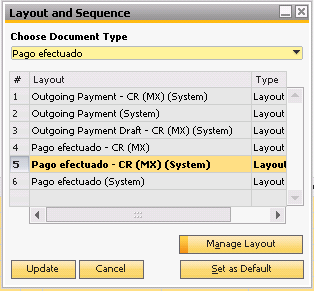Hola!, paso de forma muy rapída para compartirles esta consulta que me han solicitado mucho los agentes de ventas y que a ustedes les puede servir mucho de igual manera, saludos!.
c.CardName,
a.DocDate,
DATEPART(month , a.DocDate) AS Periodo,
DATEPART(YEAR , a.DocDate) AS Año,
case a.DocSubType
when 'DN' THEN 'Nota de débito'
when '--' THEN 'Factura'
END AS [Tipo de dcumento],
a.DocNum,
a.DocEntry IrDocumento,
b.ItemCode,
case a.DocType When 'S' THEN b.dscription ELSE
d.ItemName END AS ItemName,
b.Price,
case a.CANCELED
WHEN 'C' THEN case a.DocType When 'S' THEN -1 ELSE
b.Quantity * -1 END
WHEN 'N' THEN case a.DocType When 'S' THEN 1 ELSE b.Quantity
END
ELSE case a.DocType When 'S' THEN 1 ELSE b.Quantity END
END as Quantity,
case a.CANCELED WHEN 'C'
THEN case a.DocType When 'S'
THEN case a.CurSource
WHEN 'L' THEN (b.Price * 1) * - 1 ELSE
(b.Price * 1) * e.rate * -1 END
ELSE case a.CurSource WHEN 'L' THEN (b.Price * b.Quantity) * -1 ELSE (b.Price * b.Quantity) * e.rate *
-1 END
END
WHEN 'N' THEN
case a.DocType When 'S'
THEN case a.CurSource WHEN 'L' THEN (b.Price * 1)
ELSE (b.Price * 1) * e.rate END
ELSE case
a.CurSource WHEN 'L' THEN (b.Price *
b.Quantity) ELSE (b.Price * b.Quantity)
* e.rate END
END
ELSE
case a.DocType When 'S'
THEN case a.CurSource
WHEN 'L' THEN (b.Price * 1) ELSE (b.Price * 1) * e.rate END
ELSE case
a.CurSource WHEN 'L' THEN (b.Price *
b.Quantity) ELSE (b.Price * b.Quantity)
* e.rate END
END
END
AS [Total MXN],
case a.CANCELED WHEN 'C'
THEN case a.DocType When 'S'
THEN
case a.CurSource WHEN 'C' THEN (b.Price * 1) * -1 ELSE
(b.Price * 1) / e.rate * -1 END
ELSE
case a.CurSource WHEN 'C' THEN (b.Price * b.Quantity) * -1 ELSE (b.Price * b.Quantity) / e.rate* -1 END
END
WHEN 'N' THEN
case a.DocType When 'S'
THEN
case a.CurSource WHEN 'C' THEN (b.Price * 1) ELSE (b.Price * 1) / e.rate END
ELSE
case a.CurSource WHEN 'C' THEN (b.Price * b.Quantity) ELSE
(b.Price * b.Quantity) / e.rate END
END
ELSE
case a.DocType When 'S'
THEN
case a.CurSource WHEN 'C' THEN (b.Price * 1) ELSE (b.Price * 1) / e.rate END
ELSE
case a.CurSource WHEN 'C' THEN (b.Price * b.Quantity) ELSE
(b.Price * b.Quantity) / e.rate END
END
END
AS [Total USD],
a.CANCELED,
a.Comments
from OINV a
inner join INV1 b on
a.docentry = b.docentry
inner join OCRD c on a.CardCode = c.CardCode
left join OITM d on b.ItemCode = d.ItemCode
left join ORTT e on a.CreateDate = e.RateDate and e.Currency
= 'USD'
where a.docdate between [%0]
and [%1]
UNION ALL
select a.CardCode,
c.CardName,
a.DocDate,
DATEPART(month , a.DocDate) AS Periodo,
DATEPART(YEAR , a.DocDate) AS Año,
case a.ObjType
when 14 THEN 'Nota de Crédito'
END AS [Tipo de dcumento],
a.DocNum,
a.DocEntry IrDocumento,
b.ItemCode,
case a.DocType When 'S' THEN b.dscription ELSE
d.ItemName END AS ItemName,
b.Price,
case a.CANCELED
WHEN 'C' THEN case a.DocType When 'S' THEN 1 ELSE
b.Quantity END
WHEN 'N' THEN case a.DocType When 'S' THEN -1 ELSE
b.Quantity * - 1 END
ELSE case a.DocType When 'S' THEN -1 ELSE b.Quantity * -1
END
END as Quantity,
case a.CANCELED WHEN 'C'
THEN case a.DocType When 'S'
THEN case a.CurSource
WHEN 'L' THEN (b.Price * 1) ELSE
(b.Price * 1) * e.rate END
ELSE case a.CurSource WHEN 'L' THEN (b.Price * b.Quantity) ELSE (b.Price * b.Quantity) * e.rate END
END
WHEN 'N' THEN
case a.DocType When 'S'
THEN case
a.CurSource WHEN 'L' THEN (b.Price * 1)
* -1 ELSE (b.Price * 1) * e.rate * -1 END
ELSE case
a.CurSource WHEN 'L' THEN (b.Price *
b.Quantity) * -1 ELSE (b.Price *
b.Quantity) * e.rate * -1 END
END
ELSE
case a.DocType When 'S'
THEN case
a.CurSource WHEN 'L' THEN (b.Price * 1)
* -1 ELSE (b.Price * 1) * e.rate * -1
END
ELSE case
a.CurSource WHEN 'L' THEN (b.Price *
b.Quantity) * -1 ELSE (b.Price *
b.Quantity) * e.rate * -1 END
END
END
AS [Total MXN],
case a.CANCELED WHEN 'C'
THEN case a.DocType When 'S'
THEN
case a.CurSource WHEN 'C' THEN (b.Price * 1) ELSE (b.Price * 1) / e.rate END
ELSE
case a.CurSource WHEN 'C' THEN (b.Price * b.Quantity) ELSE (b.Price * b.Quantity) / e.rate
END
END
WHEN 'N' THEN
case a.DocType When 'S'
THEN
case a.CurSource WHEN 'C' THEN (b.Price * 1) * -1 ELSE
(b.Price * 1) / e.rate * -1 END
ELSE
case a.CurSource WHEN 'C' THEN (b.Price * b.Quantity) * -1
ELSE (b.Price * b.Quantity) / e.rate * -1 END
END
ELSE case a.DocType When 'S'
THEN
case a.CurSource WHEN 'C' THEN (b.Price * 1) * -1 ELSE
(b.Price * 1) / e.rate * -1 END
ELSE
case a.CurSource WHEN 'C' THEN (b.Price * b.Quantity) * -1
ELSE (b.Price * b.Quantity) / e.rate * -1 END
END
END
AS [Total USD],
--d.ItemName,
--b.Price,
--b.Quantity * -1,
--case a.CurSource WHEN 'L' THEN b.Price * b.Quantity * -1 ELSE (b.Price *
b.Quantity * -1) * e.rate END AS [Total MXN],
--case a.CurSource WHEN 'C' THEN (b.Price * b.Quantity * -1)
/ e.rate ELSE (b.Price * b.Quantity * -1) END AS [Total USD],
a.CANCELED,
a.Comments
from ORIN a
--left join RIN1 e on a.Docentry = e.BaseEntry
inner join RIN1 b on
a.docentry = b.docentry
inner join OCRD c on a.CardCode = c.CardCode
left join OITM d on b.ItemCode = d.ItemCode
left join ORTT e on a.CreateDate = e.RateDate and e.Currency
= 'USD'
where a.docdate between [%0]
and [%1]

